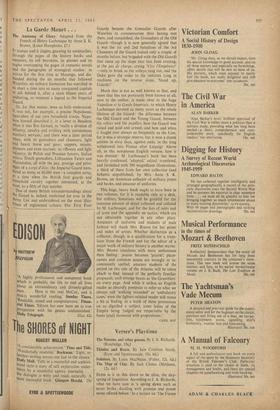La Garde Meurt . . .
The Anatomy of Glory. Adapted from the French of Henry Lachouque by Anne S. K. Brown, (Lund Humphries, 45.)
Pe tramps and it jingles, gnawing its moustaches, through the pages of the history books and memoirs, its tall bearskins, its plumes and its eagles overtopping the pages of romantic novels and the paragraphs of strategical studies: in action for the first time at Marengo, and dis- banded during the six months that followed Waterloo, no military formation has marched in so short a time into so many conquered capitals or left behind it, after a mere fifteen years of soldiering, so resonant a legend as the Imperial Guard.
Or, for that matter, been so little understood. It was not, for example, a precise Napoleonic equivalent of our own household troops. Napo- leon himself described it, in a letter to Bessieres when it was first formed, as 'really a division of infantry, cavalry and artillery with autonomous auxiliary services,' and there was a later period When, with its grenadiers and chasseurs, light and heavy horse and suns; sappers, miners, Pioneers and even marines; its riflemen and light infantry; its Polish and Prussian lancers, Italian velites, Dutch grenadiers. Lithuanian Tatars and Mamelukes; all with the pay, prestige and privi- leges of a corps d'elite; the Imperial Guard num- bered as many as 60,000 men—a complete army, .41 a time when the British foot guards and household cavalry together amounted, at the Most, to a fifth of that number.
One of many British misunderstandings about the Guard is, indeed, enshrined for ever in the Army List and embroidered on the most illus- trious of regimental colours. Our First Foot Guards became the Grenadier Guards after Waterloo to commemorate their having met there, and vanquished, the Grenadiers of the Old Guard—though it is now generally agreed that it was the 1st and 2nd battalions of the 3rd Chasseurs of the Guard (raised only a couple of months before, but brigaded with the Old Guard) that came up the slope that late June evening, at the pas de charge, crying 'Vine l'Empereurr —only to break as the volleys rang out, and the Duke gave the order to the redcoats lying in readiness on the reverse slope, 'Stand up, Guards!'
Much that is not as well known as that, and more that has not previously been known at all, save to the author, is made clear in the huge Napoleon et la Garde Imperiale, to which Henry Lachouque devoted as many years as the whole lifetime of the Guard: the difference between the Old Guard and the Young Guard, between the velites and the ',willies; how the Guard was raised and paid and armed; and how and when it fought (not always so frequently as the Line, for it was a strategic reserve, but it won a dozen actions in sixty days, against odds, in the long withdrawal into France after Leipzig). Above all, in this sumptuous English version. how it was dressed: M. Lachouque's book has been heavily condensed, 'adapted,' edited• translated, and furnished with 300 magnificent illustrations, a third of them froin her own collection (and hitherto unpublished), by Mrs. Anne S. K. Brown, an American collector of military prints and books, and amateur of uniforms.
This huge, heavy book ought to have been in two volumes, for it is readable only at a desk, but military historians will be grateful for the immense amount of detail collected and collated by M. Lachouque, and for the lists of units and of arms and the appendix on tactics, which are not obtainable together in any other place. Amateurs of uniforms and students of male fashion will thank Mrs. Brown for her prints and index of artists. Whether distinction as a collector, though, is a qualification for a trans- lator from the French and for the editor of a major work of military history is another matter. Mrs. Brown translates with more enthusiasm than feeling: prairie becomes 'prairie; place- names and common nouns are wrongly or in- consistently spelled; amateur students of the period on this side of the Atlantic will be taken aback to find, instead of the perfectly familiar grognards, such strange beasts as the Grumblers' on every page. And while it strikes an English reader as absurdly pompous to refer to what we always call 'walking wounded' as 'ambulatory cases,' even the lightest-minded reader will wince a bit at finding, in a work of these pretensions on so dignified a subject, some ladies of the Empire being 'judged not respectable by the bums [and] showered with propositions.'
CYRIL RAY














































 Previous page
Previous page